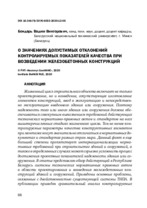О значениях допустимых отклонений контролируемых показателей качества при возведении железобетонных конструкций
Another Title
About the permitted deviation values of controlled quality indexes when building reinforced concrete constructions
Bibliographic entry
Бондарь, В. В. О значениях допустимых отклонений контролируемых показателей качества при возведении железобетонных конструкций = About the permitted deviation values of controlled quality indexes when building reinforced concrete constructions / В. В. Бондарь // Проблемы современного бетона и железобетона : сборник научных трудов / Министерство архитектуры и строительства Республики Беларусь, РУП "Институт БелНИИС" ; редкол.: О. Н. Лешкевич (председатель) [и др.]. – Минск : Колорград, 2020. – Вып. 12. – С. 86-101.
Abstract
Жизненный цикл строительного объекта включает не только проектирование, но и возведение, сопутствующее изготовление элементов конструкций, ввод в эксплуатацию и непосредствен- но эксплуатацию введенного здания или сооружения. Поэтому надежность того или иного здания или сооружения должна обеспечиваться совокупным выполнением требований действующих технических нормативно-правовых актов и стандартов на всех вышеперечисленных стадиях жизненного цикла. Тем не менее контролируемые параметры качества конструктивных элементов при монтаже могут значительно отличаться в нормативных документах и стандартах разных стран мира. Данный факт в еще большей степени препятствует интернационализации нормативных требований при строительстве зданий и сооружений, а также в определенных случаях может серьезно усложнить процесс достижения проектных показателей надежности здания или сооружения. В статье представлен обзор действующей в Республике Беларусь системы технических нормативных правовых актов в области проектирования и возведения железобетонных кон- струкций зданий и сооружений. Приведены основные проблемы, связанные с двойственностью существующей системы ТНПА. В публикации приведен сравнительный анализ контролируемых показателей качества (величин допустимых отклонений), представленных в действующих нормативных документах и стандартах Республики Беларусь и других ведущих стран мира, при возве- дении железобетонных элементов зданий и сооружений. На основе анализа контролируемых показателей качества сформулированы основные выводы, которые указывают на необходимость совершенствования системы национальных нормативных документов в области возведения железобетонных конструкций зданий и сооружений, а также на проблемы, которые могут возникать при одновременном действии в стране нескольких систем нормативной документации, в ряде случаев не согласующихся друг с другом.
Abstract in another language
The life cycle of a construction project includes not only design, but also erection, concomitant manufacture of structural elements, commissioning and direct operation of the commissioned building or structure. Therefore, the reliability of a building or structure should be ensured by the combined fulfillment of the requirements of the existing technical normative legal acts and standards at all of the above stages of the life cycle. Nevertheless, the monitored controlled quality indexes of structural elements and their geometric configuration during installation can significantly differ in regulatory documents and standards around the world. This fact further impedes the internationalization of regulatory requirements in the construction of building and structures, and in certain cases can seriously complicate the process of achieving design indicators of the reliability of a building, or structure. The article provides an overview of the current system of technical regulatory legal acts in the field of design and execution of reinforced concrete structures of buildings and constructions. The main problems associated with the duality of the existing TRLA system, as well as with relatively difficult economic conditions, complicated by internal and external factors, are presented. The publication provides a comparative analysis of the controlled quality indexes (permitted deviation values) presented in the current regulatory documents and standards of the Republic of Belarus and other countries of the world during the erection of reinforced concrete elements of buildings and structures. Based on the analysis of the controlled quality indexes, the main conclusions are formulated, indicating the need to improve the system of national regulatory documents in the field of erection of reinforced concrete structures of buildings, as well as the problems that may arise when several regulatory systems operate simultaneously in the country, and in some cases do not agree with each other.

